Evaluation of Natural Pigments as Antioxidant and Antibacterial Agents from Tagetes Erecta Flowers Extracts
Mariya Saani1 , Reena Lawrence2 and Kapil Lawrence3
, Reena Lawrence2 and Kapil Lawrence3
1Department of Chemistry, Sam Higginbottom University of Agriculture, Technology and Sciences (Formerly AAI-DU), 211007, Allahabad, India.
2Department of Biochemistry and Biochemical Engineering, Sam Higginbottom University of Agriculture, Technology and Sciences (Formerly AAI-DU), 211007, Allahabad, India.
3Department of Molecular and Cellular Engineering, Sam Higginbottom University of Agriculture, Technology and Sciences (Formerly AAI-DU), 211007, Allahabad, India.
Corresponding Author E-mail: mariya.saani@gmail.com
DOI : http://dx.doi.org/10.13005/ojc/340551
Article Received on : 21-07-2018
Article Accepted on : 25-09-2018
Article Published : 17 Oct 2018
The present work is designed to evaluate the antioxidant, antibacterial activity and (TPC) total phenolic content of Tagetes erecta flowers extracts. Antioxidant potential of flowers extracts was examined by applying three different methods. Antibacterial test was determined against gram positive and gram negative bacterium. The ethyl acetate extract had the greater phenolic concentration of 48.2 mg/g GAE followed by methanol extract which was 42.5 mg/g GAE and hexane extract 36.4 mg/g GAE. The ethyl acetate extract was found to be most effective in all the antioxidant methods in correlation with the TPC value. Moreover, all the flowers extracts are significantly effective in both Gram negative and Gram positive bacterium. Tagetes erecta flowers are hopefully considered as a promising source of natural pigments with a scope towards the alternative therapy for treatment of various health problems.
KEYWORDS:Antibacterial; Antioxidant; Tagetes Erecta; Total Phenolic Content
Download this article as:| Copy the following to cite this article: Saani M, Lawrence R, Lawrence K. Evaluation of Natural Pigments as Antioxidant and Antibacterial Agents from Tagetes Erecta Flowers Extracts. Orient J Chem 2018;34(5). |
| Copy the following to cite this URL: Saani M, Lawrence R, Lawrence K. Evaluation of Natural Pigments as Antioxidant and Antibacterial Agents from Tagetes Erecta Flowers Extracts. Orient J Chem 2018;34(5). Available from: http://www.orientjchem.org/?p=51013 |
Introduction
Several plants, parts of plants or plants extracts comprises a number of natural products that have some association with medical properties and are used in healthcare or in combating disease. From the last three decade there is a huge increase in the use of natural products has been considered. Among the several natural products, naturally occurring plant pigments including vitamin C, carotenoids, and phenolic compounds such as flavonoids, xanthenes, tannins, and coumarins are one of them which have pharmaceutical and therapeutic effects, for antioxidant, antibacterial, anti-infectious and anticancer activities.
Several studies reported that a sufficient supply of antioxidants from the dietary sources like fruits, and vegetables might help to prevent or delay of oxidative stress which is the major cause of many prolonged and degenerative diseases including diabetes mellitus, ageing, atherosclerosis, heart disease, cancer and neurodegenerative disease.1 Oxidative stress generates by different free radical species. Antioxidants are group of compounds which possess the ability to neutralized free radicals and provides protection from oxidative stress.2 In many places around the world, natural products from medicinal plants are not only the major source of medicine for commercial or geographical reasons but also in pockets in every opulent society. Recently there is much concern about the promising natural products as far as most chief pharmaceutical companies are concerned and the natural world is once again getting interest.3
A variety of Tagetes species are grown all over the world which has a historic evidence for its therapeutic and religious value as a natural medicine in the treatment of like hiccups, dermatitis, athlete’s foot, wound burns etc.
Tagetes erecta (African marigold) belongs to Tagetes (Asteraceae) family is a multipurpose plant having medical, colorant, food, ritual, anti-oxidative, anthelmintic and insecticidal applications.4 The flowers are raised commercially for religious and social purpose and used in folk medicines. Thus, from the above views, the present work is designed to evaluate the antioxidant potential of three extracts (hexane, ethyl acetate and methanol) of Tagetes erecta flowers using three different methods and antibacterial activity along with the determination of TPC spectrophotometrically.
Materials and Methods
Plant Material
Tagetes erecta flowers were collected from the Horticulture fields of SHUATS, Allahabad. The plant was identified by the Department of Horticulture, SHUATS, Allahabad. The Tagetes erecta flowers petals were cleaned and subjected to dryness at room temperature. The dried flowers were grinded and powdered by using sterile laboratory mortar and pestle fig 1.
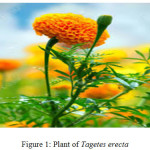 |
Figure 1: Plant of Tagetes erecta. |
Preparation of Extracts
The 60 g of dried and powdered plant material were extracted with different solvents hexane, ethyl acetate, and methanol by using soxhlet extraction apparatus at their boiling point for 48 hours. What man No. 1 filter paper was used for the filtration of these extracts. The extracts were evaporated to dryness and were used for further investigation.
Total Phenolic Content (Folin-Ciocalteu Method)
Folin-Ciocalteu method was used to determine TPC in extracts.5 In this method, 0.75 ml of Folin-Ciocalteu reagent (1 ml in 10 ml of DW) was mixed with 0.1 ml (1 mg/ml) of flowers extract stock solution and stand up to 5 min. After which aqueous sodium carbonate (100 mg/ml) with 0.75 ml was added and makeup the volume of the reaction mixture to 10 ml by the addition of DW. The mixture was allowed to incubate for 90 min. Different dilutions of Gallic acid (2, 1, 0.5, 0.25, 0.125, 0.0625 mg/ml) were prepared for the derivation of the standard curve. The absorbance was taken with the help of spectrophotometer at 760 nm. The total phenolic values were calculated and expressed in terms of milligrams of Gallic acid per 10 ml of extract.
Antioxidant Activity
DPPH Method
DPPH˙(2, 2-diphenyl-1-picryl hydrazyl) testing method was applied for measurement of the antioxidant activity. The method given above is the same as used by Kahalaf et al., (2008) with slight modification. Absorbance was read at 517 nm using UV-Visible spectrophotometer. BHT was used as standard. The radical scavenging activity of each extract was calculated by using the following equation:

Where: A= control absorbance, B= sample absorbance
IC50 value= concentration of the reaction mixture that scavenged the 50% amount of free radicals which was calculated with help of a graph between the concentration and percentage inhibition.
Ferric Thiocyanate Method (FTC)
This is another method to estimate the antioxidant potential of extracts.7 The absorbance was measured at 500 nm using UV-Visible Spectrophotometer. The absorbance was taken at every 24 hours until the maximum value of control absorbance was obtained. Standard (BHT) was used here. The lipid per-oxidation percentage inhibition was measured as follows:
(%) Inhibition = 100 – [(Asample / Acontrol) X 100]
Thio barbituric Acid (TBA) Method
The TBA test has been conducted according to Huda-Faujan et al., (2009). The absorbance was read for supernatant at 532 nm.
Antibacterial Activity
Agar Well Diffusion Method
Agar well method was applied to examine the antibacterial potential of the plant extracts.8 In this work antibacterial activity of the flowers extracts of Tagetes erecta was tested against four bacterial strains (S. aureus, B. subtilis, S. dysenteriae and E. coli). Petri plate was prepared by pouring 15 ml of molten nutrient agar (N.A.) medium for the growth and development of bacterial strain. About (108-109) colony-forming unit per ml was used. 10 ml of microbial broth was speared uniformly on nutrient agar plate. 5 mm size wells were cut with a sterilized borer on the N.A. plates having microbial culture. Plant extract of 20μl volume with concentration (0.5, 1.0, 1.5, 2.0mg/ml) was poured into the wells of N.A. plates. Ampicillin (10 mg/ml) and methanol were used as a positive and negative control which were poured into wells of nutrient agar plates in place of sample extract. After the diffusion of the sample into the wells, the prepared plates were incubated at 370C for 24 hours. The plates were checked after 24 hours. Antibacterial activity was confirmed by the appearance of an inhibition zone (ZI) around the wells containing sample extracts. The ZI was calculated and termed in millimeters. Antibacterial potential was taken into account if the sample showed ZI greater than 4 mm size, <4.5 mm size was measured as inactive, 4.5-6 mm as partially active, 6.5-9 mm as active whereas greater than 9 mm as highly active against bacterial strains.9
Results and Discussion
TPC of Extracts
Redox nature of the phenolic compounds supposed to be responsible for the antioxidant potential of plants. These are secondary plant metabolites and contribute to the plants antioxidant ability.
Folin-Ciocaltue method was used to determine the TPC of Tagetes erecta flowers extracts using Gallic Acid as the standard. The TPC was calculated with a regression equation based on a standard curve using Gallic acid at different concentration (y=0.077x, R2=0.998) and expressed in milligrams of Gallic acid. From Fig: 2 it could be interpreted that ethyl acetate extract had the greater phenolic concentration of 48.2 mg/g GAE (Gallic acid equivalents) followed by methanol extract which was 42.5 mg/g GAE and hexane extract 36.4 mg/g GAE.
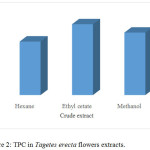 |
Figure 2: TPC in Tagetes erecta flowers extracts.
|
Antioxidant Activity
DPPH˙ Method
In present work, scavenging potential was determined by DPPH˙ testing method, which was found to be rapid, easy and economical for measurement antioxidant activity. The reducing nature of DPPH˙ free radicals was determined by decrease in its absorbance induced by antioxidants at 517 nm. The scavenging power of Tagetes erecta flowers extracts in DPPH˙ method was determined at various concentrations. Five different working solutions of three flowers extracts of Tagetes erecta (hexane, ethyl acetate and methanol extracts) were used having different concentration (1, 0.5, 0.25, 0.125, 0.0625 mg/ml). It was observed that as the concentration of samples increases, the percentage free radical scavenging activity also increases.
Among all the three sample extracts of Tagetes erecta studied, the ethyl acetate extract at 1.0 mg/ml concentration exhibited highest antioxidant potential (72.2%) followed by methanol extract (68.69%) and hexane extract (56.4%). It was further observed that all the tested samples showed significant DPPH˙ radical scavenging activity when compared with the standards. The highest activity was obtained for the ethyl acetate extract as compared to the BHT and other extracts. The methanol and hexane extracts efficiently minimized the DPPH˙ free radical concentration near to the standard (BHT). The Fig. 3 showed the antioxidant potential in decreasing order:-ethyl acetate > standard (BHT) > methanol > hexane.
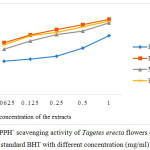 |
Figure 3: DPPH˙ scavenging activity of Tagetes erecta flowers extracts and standard BHT with different concentration (mg/ml). |
In this study, highest DPPH˙ scavenging activity was shown by ethyl acetate extract of Tagetes erecta with IC50 0.0627 value mg/ml followed by methanol extract with IC50 0.0716 value mg/ml and hexane extract with IC50 0.559 value when compared with IC50 of BHT 0.0656 mg/ml.
FTC Method
FTC method measured the amount of peroxide value in the beginning of liquid per-oxidation. Lower absorbance of the test samples correlates to its high antioxidant activity.10 A lower level of antioxidant activity is related to the higher absorbance value.
In FTC method, all the flowers extracts of Tagetes erecta become oxidized after seven days of storage and exhibited strong antioxidant potential. From the Fig: 4 the percentage of inhibition of linoleic acid by ethyl acetate, methanol, hexane extract and BHT were found to be 73.65%, 69%, 58% and 70% respectively. Initially the highest percent inhibition is shown by ethyl acetate (73%) followed by methanol extract (69%) and hexane extract exhibited the lower percent inhibition (58%). The standard (BHT) and all the extracts exhibited following order:- ethyl acetate > standard (BHT) > methanol> hexane.
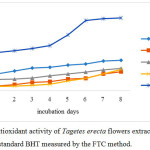 |
Figure 4: Antioxidant activity of Tagetes erecta flowers extracts and standard BHT measured by the FTC method. |
TBA Method
FTC method measured the amount of peroxide value in the beginning of liquid per-oxidation. On the other hand TBA method is used to measure extent of lipid per-oxidation at secondary stage where peroxide decomposes to form carbonyl compounds. Malonaldehyde (Secondary product) is a short lived species & readily converts into acids and alcohols. It is very difficult to detect these species by UV-VIS spectrophotometer. All the extracts showed strong antioxidant activity. The absorbance of control sample obviously showed the highest reading. This result is similar to that reported by Huda-faujan (2009).
After seven days of storage, all the extracts exhibited good effect in inhibiting secondary product of oxidation compared to control. From the Fig. 5 the percentage of inhibition of ethyl acetate, methanol, hexane extract and BHT were found to be 68.75%, 61%, 54.32% and 63.46% respectively. Initially the highest percent inhibition was shown by ethyl acetate (68.75%) followed by methanol extract (61%) and hexane extract exhibited the lower percent inhibition (54.32%). The activity order is as follows:-ethyl acetate > standard (BHT) > methanol> hexane.
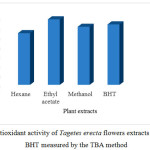 |
Figure 5: Antioxidant activity of Tagetes erecta flowers extracts and Standard BHT measured by the TBA method. |
Antibacterial Activity
Agar Well Diffusion Method
Antibacterial activity was confirmed by the appearance of an inhibition zone (ZI) around the wells containing sample extracts. The ZI was calculated and termed in millimeters. Antibacterial potential was taken into account if the sample showed ZI greater than 4 mm size, < 4.5 mm size was measured as inactive, 4.5-6 mm as partially active, 6.5-9 mm as active whereas greater than 9 mm as highly active against bacterial strains.9 In present study, Tagetes erecta flowers extracts (methanol, ethyl acetate and hexane) were screened for their antibacterial activity by agar well diffusion method against four pathogenic bacteria (E. coli, S. dysenteriae, B. subtilis and S. aureus) using ampicillin as standard antibiotic and DMSO as control. The extracts showed inhibitory activity against all the four pathogenic bacteria at different concentrations i.e. 0.5, 1.0, 1.5 and 2.0 mg/ml. It was found that ZI was increased with concentration of test samples. In Tagetes erecta flowers extracts (methanol, ethyl acetate and hexane) radius of ZI varied from 10.3 to 24 mm, 14 to 24.8 mm and 13.6 to 20 mm, respectively. At 2.0 mg/ml concentration of methanol extract showed highest ZI 24 mm for B. subtilis whereas 21.6 mm towards S. aureus, 17.5 mm against E. coli and 10.3 mm against S. dysenteriae. The lowest concentration (0.5 mg/ml) of methanol extract displayed highest ZI 18.3 mm towards B. subtilis and lowest 8 mm against S. dysenteriae. Likewise 2.0 mg/ml concentration of ethyl acetate extract showed maximum ZI 24.8 mm for B. subtilis while 19 mm for E. coli, 18 mm against S. aureus and 14 mm against S. dysenteriae. The ethyl acetate extract at (0.5 mg/ml) concentration showed highest ZI 18 mm towards B subtilis whereas lowest 12 mm for S. dysenteriae. Tagetes erecta hexane extract with 2 mg/ml concentration showed highest radius of ZI of 20 mm for B. subtilis while 18 mm for E. coli, 16.7 mm against S. aureus and 13.9 mm against S. dysenteriae. The radius of ZI of Tagetes erecta flowers extracts against different bacteria was close to the ampicillin used as standard antibiotic. The ethyl acetate extract of Tagetes erecta flowers exhibited the highest ZI (24.8 mm) towards B. subtilis which is same as shown by ampicillin (standard antibiotic) against the same bacteria. Fig. 6 summarizes the microbial growth inhibition of the three extracts of Tagetes erecta flowers (concentration 2 mg/ml).
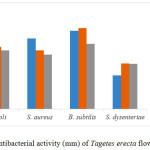 |
Figure 6: Antibacterial activity (mm) of Tagetes erecta flowers extracts. |
Several studies reported the direct relationship in between natural pigments and strong antioxidant potential. Natural pigments like flavonoids, carotenoids and phenolic compounds exhibit considerable amount of free radical terminating potential due to their hydrogen or electron-donating nature.11 Present study has shown that hexane, ethyl acetate and methanol extracts of Tagetes erecta flowers possess considerable amount of natural compounds and exhibit a strong correlation in between the antioxidant, antibacterial activity & TPC. Natural pigments are found to be powerful scavengers of ROS, and significantly provide healthy life style.12 The antioxidant activity of Tagetes erecta extracts determined by three methods showed that this plant may act as excellent source of natural antioxidant as their antioxidant activity is close to that of the standard (BHT) used. Above results agree with the previous studies that show that Tagetes erecta has significantly active against various pathogenic and opportunistic bacteria.13 From the present work it can be clearly specified that the all the extracts of Tagetes erecta are propitious source of natural pigments and significantly used as antioxidant & antibacterial agent. The results also suggests that the Tagetes erecta flowers are hopefully considered as a promising source of natural compounds with an scope towards the alternative therapy for treatment of various health problems. Thus, justifying their traditional uses as a natural antioxidant antibacterial agent.
Acknowledgement
I am very grateful to my guide, Dr. Reena Lawrence research supervisor for her encouragement and support in my work.
References
- Sharmila, P. M. Jenefer.; Jaganathan, D.; Kumaravel, S. Quantification of antioxidants in Underutilized vegetable leaves. Int J Cur Res Rev. 2016, 8(10).??2016
- Canadanovic –Brunet, J. M.; Savatovic, S. S.; Cetkovic, G. S.; Vulic, J. J.; Dililas, S. M.; Markov, S. L.; Cvetkovic, D. D. Antioxidant and Antibacterial activities of Beet root Pomace extract. Czech J. Food Science. 2011, 29, 575-585.
- Kusumaa, I. W.; Murdiyantoa.; Arunga, E. T.; Syafrizalb.; Kim, Y. Antimicrobial and antioxidant properties of medicinal plants used by the Bentian tribe from Indonesia. Food Science and Human Wellness. 2014, 3, 191–196.
CrossRef - Ingkasupart, P.; Manochai, B.; Song, W. T.; Hong, J. H. Antioxidant activities and lutein content of 11 marigold cultivars (Tagetes spp.) grown in Thailand. Food Sci. Technol, Campinas. 2015, 35(2), 380-385.
CrossRef - Velioglu, Y. S.; Mazza, G.; Gao, L.; Oomah, B. D. Antioxidant activity in fruits and Total Phenolic in selected fruits, vegetables, and grain products. J of the Sci. of Food and Agriculture. 1998, 46, 4113–4117.
CrossRef - Khalaf, N. A.; Shakya, A.; Al-olhman, A.; El-Agbar, Z.; Farah, H. Antioxidant and Antiinflammatory activity of Ethanolic extract of Beta–vulgaris linn roots. Turkish J. biol. 2008, 32, 51-55.
- Huda-Faujan, N.; Noriham, A.; Norrakish, A. S.; Babji, A. S. Antioxidant activity of plant methanolic extracts containing phenolic compounds. African J. of Biotech. 2009, 8(3), 484-489.
- Ahmad, I.; and Beg, A. J. Antimicrobial and phytochemical studies on 45 Indian medicinal plants against multidrug resistant human pathogens. J of Ethnopharmacology. 2001, 74, 111-123.
CrossRef - Dar, S.; & Lawrence, R. S. Evaluation of antibacterial properties of fruit peel extracts of Citrus karna against human pathogens. Int J Pharm Bio Sci. 2015, 6(1), 261 – 266.
- Aris, S. R. S.; Mustafa, S.; Ahmat, N.; Jaafar, F. M.; Ahmad, R. Phenolic Content and Antioxidant activity of fruits of Ficus Deltoidea Varangustifolia spe. The Malaysian Journal of Agriculture Science. 2009, 13(2), 146-150.
- Li, H.; Wang, X.; Li, P.; and Wang, H. Polyphenolic compounds and antioxidant properties of selected China wines. Food Chemistry. 2009, 112, 452-460.
CrossRef - Karuppanapandian, T.; Moon, J.; Kim, C.; Manoharan, K.; Kim, W. Reactive oxygen species in plants: their generation, signal transduction, and scavenging mechanism. Aust J Crop Sci. 2011, 5(6), 709-725.
- Jain, R.; Katare, N.; Kumar, V.; Samanta, A. K.; Goswami, S.; and Shrotri, C. K. In vitro Antibacterial potential of different extracts of Tagetes erecta and Tagetes patetula. J. of Nat. Sci. Res. 2012, 2(5).

This work is licensed under a Creative Commons Attribution 4.0 International License.









